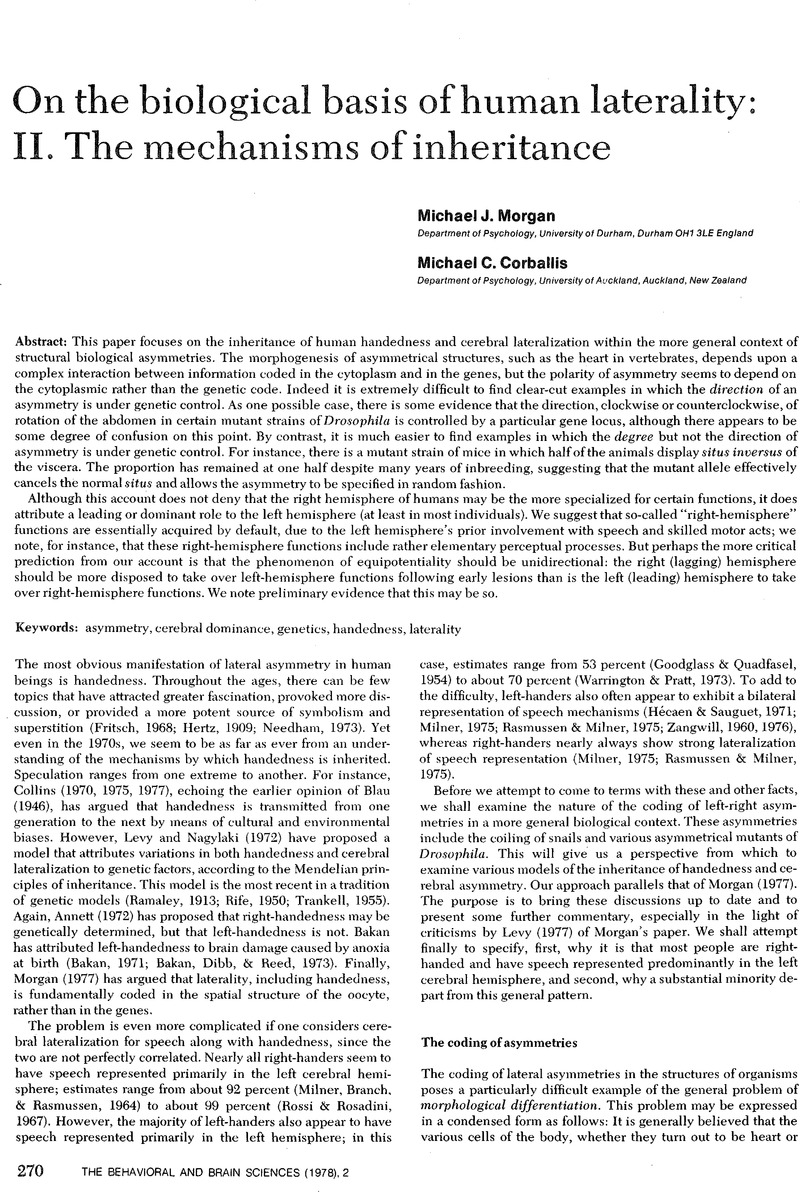Crossref Citations
This article has been cited by the following publications. This list is generated based on data provided by Crossref.
Bradshaw, John L.
1981.
Hemispheric laterality and an evolutionary perspective.
Behavioral and Brain Sciences,
Vol. 4,
Issue. 1,
p.
21.
Lehman, Ralph A. W.
1981.
Lateralized asymmetry of behavior in animals at the population and individual level.
Behavioral and Brain Sciences,
Vol. 4,
Issue. 1,
p.
28.
Giurgea, Corneliu E.
1981.
How and why two brains?.
Behavioral and Brain Sciences,
Vol. 4,
Issue. 1,
p.
27.
Denenberg, Victor H.
1981.
Population asymmetry and cross-species similarity.
Behavioral and Brain Sciences,
Vol. 4,
Issue. 1,
p.
38.
Warren, J. M.
1981.
Laterality and natural selection.
Behavioral and Brain Sciences,
Vol. 4,
Issue. 1,
p.
36.
Geschwind, Norman
1981.
The significance of lateralization in nonhuman species.
Behavioral and Brain Sciences,
Vol. 4,
Issue. 1,
p.
26.
Bureš, Jan
Burešová, O.
and
Krivánek, J.
1981.
An asymmetric view of brain laterality.
Behavioral and Brain Sciences,
Vol. 4,
Issue. 1,
p.
22.
Rogers, L. J.
1981.
Environmental influences on brain lateralization.
Behavioral and Brain Sciences,
Vol. 4,
Issue. 1,
p.
35.
Nelsen, Judith M.
and
Goldstein, Leonide
1981.
Electrophysiological measures of hemispheric lateralities related to behavioral states in animals.
Behavioral and Brain Sciences,
Vol. 4,
Issue. 1,
p.
32.
Milner, A. D.
and
Jeeves, M. A.
1981.
The functions of the corpus callosum in infancy and adulthood.
Behavioral and Brain Sciences,
Vol. 4,
Issue. 1,
p.
30.
Collins, Robert L.
1981.
On asymmetries exhibiting a near-equiprobable distribution of directions.
Behavioral and Brain Sciences,
Vol. 4,
Issue. 1,
p.
23.
Záborszky, László
1981.
The corpus callosum and hemispheric lateralization.
Behavioral and Brain Sciences,
Vol. 4,
Issue. 1,
p.
37.
Levy, Jerre
1981.
Cross-species invariances and within-species diversity in brain asymmetry and questions regarding inferences about lateralization.
Behavioral and Brain Sciences,
Vol. 4,
Issue. 1,
p.
28.
Myslobodsky, Michael S.
1981.
Animal brain laterality: Functional lateralization or a right-left excitability gradient?.
Behavioral and Brain Sciences,
Vol. 4,
Issue. 1,
p.
31.
Ettlinger, G.
1981.
Cerebral predominance in the monkey?.
Behavioral and Brain Sciences,
Vol. 4,
Issue. 1,
p.
25.
Corballis, Michael C.
1981.
On the evolution and growth of lateralization.
Behavioral and Brain Sciences,
Vol. 4,
Issue. 1,
p.
24.
Robinson, Daniel N.
1981.
Conceptual aspects of “laterality” syndromes.
Behavioral and Brain Sciences,
Vol. 4,
Issue. 1,
p.
33.
Puccetti, Roland
1981.
Possible anatomic basis for cerebral dominance in infrahuman vertebrate species.
Behavioral and Brain Sciences,
Vol. 4,
Issue. 1,
p.
33.
Denenberg, Victor H.
1981.
Hemispheric laterality in animals and the effects of early experience.
Behavioral and Brain Sciences,
Vol. 4,
Issue. 1,
p.
1.
Robinson, Terry E.
and
Becker, Jill B.
1981.
Variation in lateralization: Selected samples do not a population make.
Behavioral and Brain Sciences,
Vol. 4,
Issue. 1,
p.
34.





